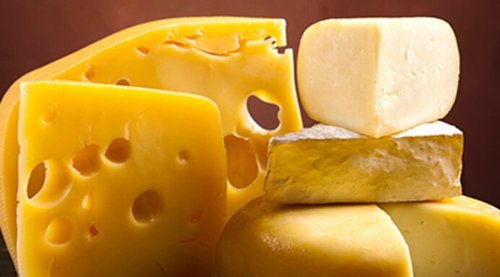By now, you have probably heard dairy is either good for you or bad for you, depending on the latest diet trend or the most recent study. Dairy products like milk, yogurt, and cheese are excellent sources of calcium, which helps you maintain bone density and reduces the risk of breaks or fractures. And while dairy isn’t necessary for optimal health and wellness, it is one of the easiest ways to get the calcium, vitamin D, and protein you need to keep your heart, muscles, and bones healthy and properly functioning. Or is it?
I used to proudly proclaim cheese should be its own food group and shouldn’t be lumped in with dairy, but considering cheese is produced from the milk of mammals, such as cows and goats—and that is basically the definition of dairy—I suppose it can stay there.
BREAKING: Shed 42 lbs In 30 Days With This Simple Night-time Pill
But if you really take a look at the composition of various cheeses, they differ from other dairy products like milk and yogurt, which may then result in different effects on cardiovascular health. For example, some evidence of an association between consuming cheese and the risk of coronary heart disease and stroke has been reported. In addition, with folks who have an impaired glycemic state at baseline, cheese intake has been associated with diabetes, even after adjusting for BMI (body mass index) and other risk factors.
According to the Physicians Committee for Responsible Medicine, “Americans eat more than 33 pounds of cheese per person per year—three times more than they did in 1970—and our country is more obese than ever… Cheese is a high-calorie product loaded with fat, sodium, and cholesterol.”
Why Cheese is Bad For You
Cheese is a fermented dairy product and traditionally part of the Mediterranean diet. It’s consumed by billions of people around the world every day. A healthy eating pattern in the 2015 – 2020 Dietary Guidelines for Americans includes milk, yogurt, and cheese. However, the guidelines also point out that it would be most beneficial if more fat-free or low-fat milk products were selected rather than full-fat cheese.
Some types of cheese are loaded with calories, not to mention fat. And we aren’t talking about the good type of fat—this is purely saturated fat. The kind that clogs arteries and is darn near impossible to get rid of in the gym.
Plus, a lot of the cheeses today have a ton of sodium. For those who are prone to heart disease, too much sodium is definitely not something that’s considered heart-healthy.
While you may be sourcing your cheese from a reputable source, some manufacturers are getting away with more and more unhealthy methods for producing milk (to make cheese). The animals can be treated like milk-producing machines. Many are often genetically manipulated as well as loaded up with antibiotics and hormones to help them produce more milk. Of course, how cows are treated can have a big effect on how healthy their products (whether meat or dairy) are. The cows that suffer on factory farms produce less healthy products, and the humans that consume the products may, in turn, increase their chances of developing heart disease, diabetes, cancer, and other ailments.
Something else unsavory manufacturers are doing is adding enzymes called rennet to the animals’ stomachs. This is done to help kill off bacteria, but it’s not foolproof and could be doing more harm than good for both the animals and those who consume the products made from them.
And if that wasn’t enough, some producers add cellulose, a plant fiber (basically pulp from wood) to pre-packaged shredded cheese varieties, which is a method used to prevent the shredded products from sticking together. “Hey, can I get some wood shavings on my taco?” said no one ever.
But back to the good stuff—didn’t I previously mention cheese is a good source of protein and calcium?
It is, but according to Sydney Greene, MS, RDN, “Most cheese on the market is not even real cheese. You may notice that most of the cheese is labeled, ‘product or cheese food.’ This is because when a food contains a high amount of additives, making up more than 51% of the product, it cannot be named the whole food.”
So, What Are The Healthiest Types of Cheese?
If you find yourself unable to quit cheese, might I suggest cottage cheese or ricotta cheese?
Cottage cheese is a curd-based fresh cheese which naturally contains less fat (and therefore calories) than other cheeses. It provides six percent fat (with three percent saturated fat). You can also buy low-fat versions, which provide just two percent fat with one percent saturated fat.
Ricotta cheese is one of the world’s oldest cheeses. In fact, it dates back to the Bronze Age. This Italian curd cheese is made from the whey that’s left over after other cheese is produced. Compared to most cheeses, ricotta contains less salt as well as fat (10% fat with 6% saturated fat). It’s light and creamy with a subtle flavor that can be used on its own or in sweet as well as savory dishes. And, of course, ricotta cheese is used to make cannolis. Who doesn’t love a cannoli?
Is Cheese Bad: A Recap
The consumption of a variety of foods is vital for supporting growth, increasing strength, improving cognitive function, and reducing the risk of chronic diseases, illnesses, and infection. This may or may not include cheese for you, depending on how it fits in with your healthy diet.
Fuhgeddaboudit if you are someone who has been diagnosed as lactose intolerant. No amount of digestive distress is worth keeping cheese in your diet.
If you are looking to increase calcium in your diet, why not try one of the following:
- Chia Seeds: 2 tablespoons provide 179 mg of calcium.
- Almonds: 1 cup of whole almonds contains 385 mg of calcium.
- Dried Figs: 1 cup provides 241 mg of calcium.
- Tofu: ½ cup can provide between 275–861 mg of calcium.
- White Beans: One cup yields 161 mg of calcium.
- Kale: 2 cups provide about 180 mg of calcium.
- Sunflower Seeds: 1 cup contains 109 mg of calcium.
- Broccoli Rabe: 1 cup provides 100 mg of calcium.
TRENDING: Diabetes Breakthrough Leaves Doctors Speechless - Try This Tonight
And other sources of vitamin D include salmon, tuna, cod, mackerel, catfish, and other fatty fish, shrimp, and eggs. And let’s not forget the gift that is the sun.
Finally, if you’re looking for protein, other sources include:
- Spirulina
- Chia Seeds
- Pumpkin Seeds
- Hemp Seeds
- Lentils
- Whey Protein
- Peanut Butter
- Eggs
- Liver
- Grass-Fed Beef
- Wild Salmon
- Sardines









